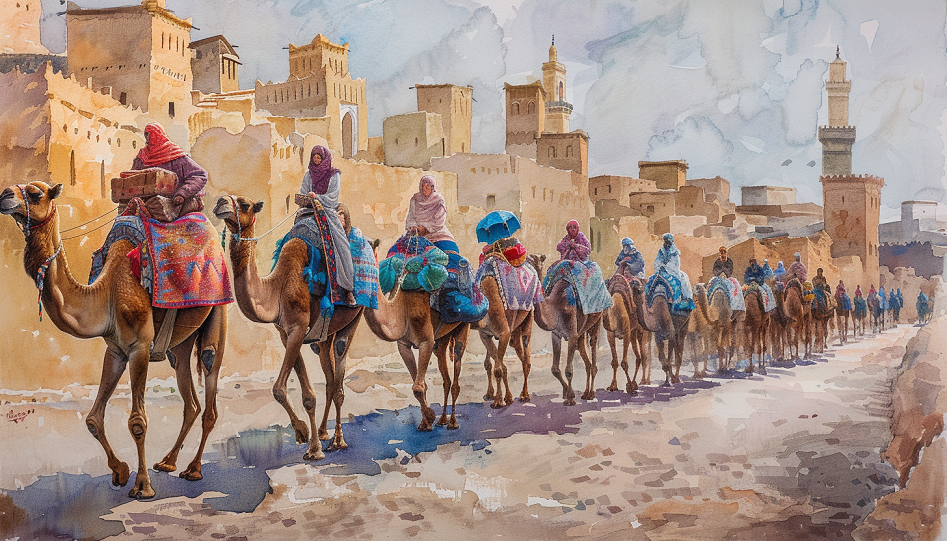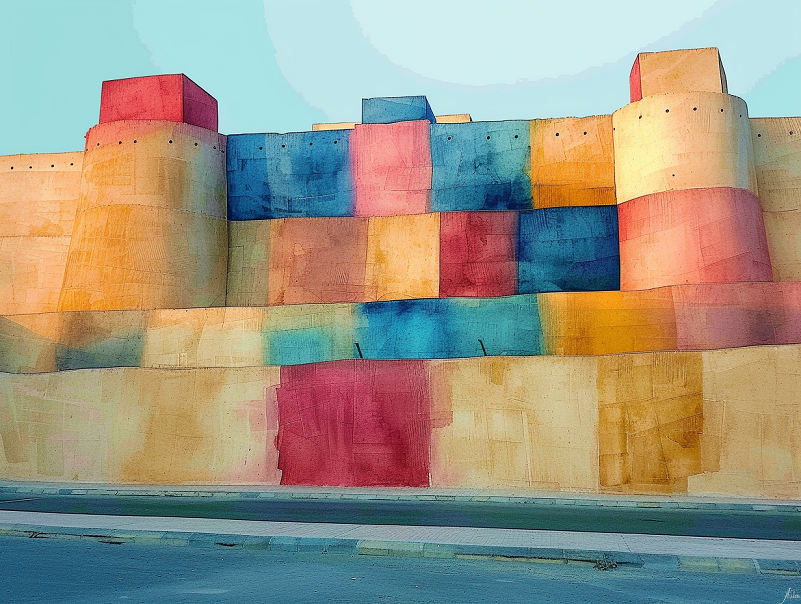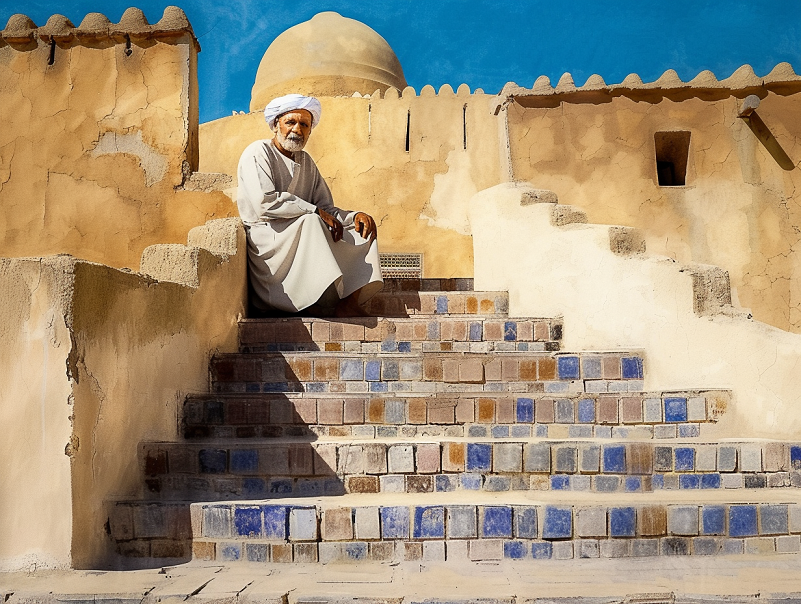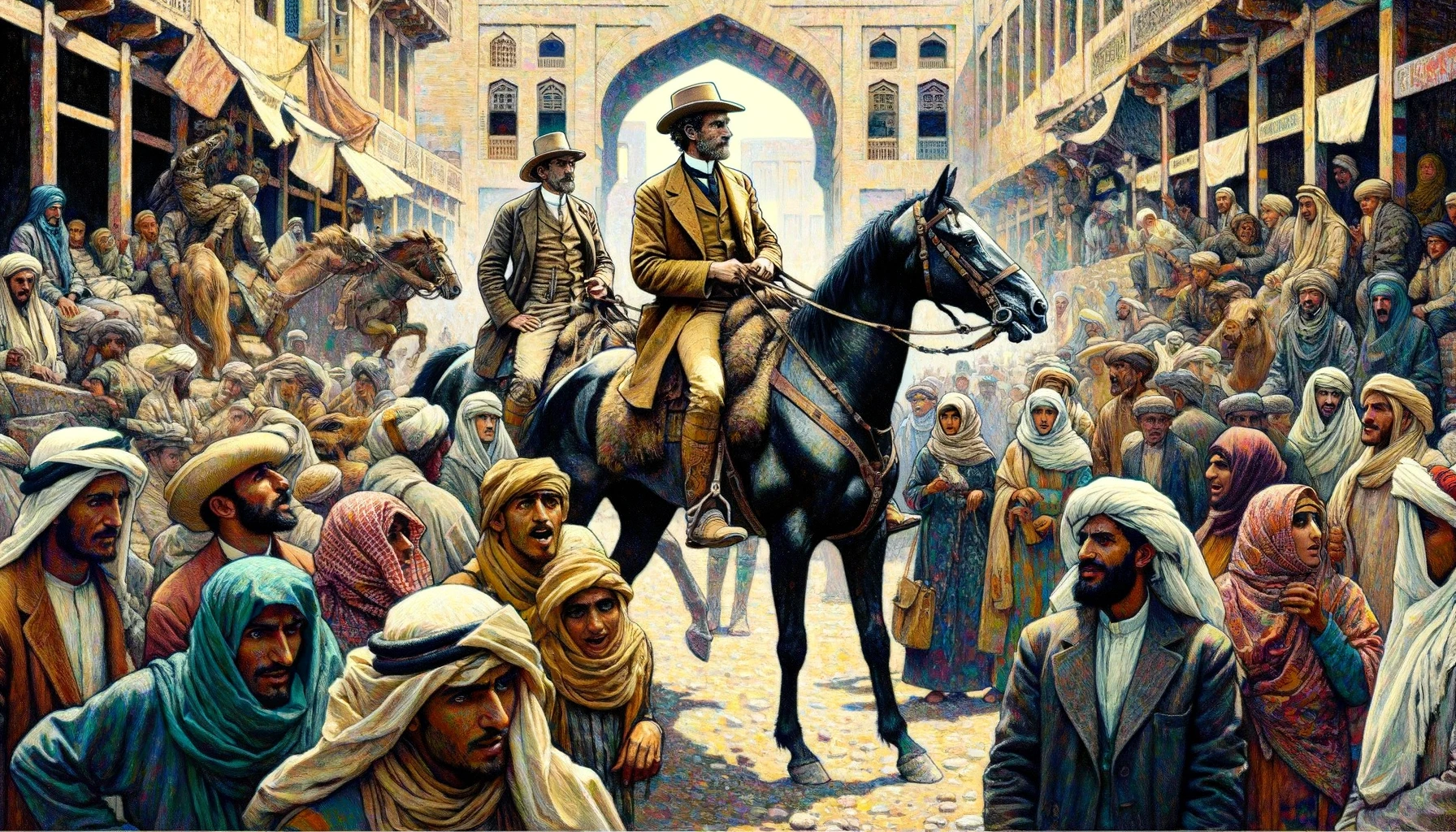Harry St. John Philby, an esteemed British explorer and author, embarked on a remarkable journey through the eastern desert of Saudi Arabia, an adventure chronicled in his book, “Heart of Arabia.” This exploration not only shed light on the vast and arid landscapes of the Arabian Peninsula but also offered profound insights into the cultural dynamics, social customs, and logistical challenges of early 20th-century travels in the region. Philby’s experiences in places like Hufuf and the square fort of Khizam, and his observations of the Arabian attire and caravan logistics provide a vivid tableau of his expedition.
- Harry St. John Philby’s exploration of Saudi Arabia was marked by meticulous preparation and cultural adaptation.
- The Summan desert posed significant navigational and logistical challenges due to its vast and barren landscape.
- Local attire and customs played a crucial role in facilitating smoother interactions with the indigenous populations.
- The caravan’s composition, including over thirty camels and twenty-five persons, highlighted the collaborative nature of desert exploration.
- Strategic planning, including the procurement of water and supplies, was essential for survival in the desert’s harsh conditions.
Initial Stay and Observations in Hufuf
Harry St. John Philby’s sojourn in Hufuf marked the commencement of his expedition into the eastern deserts of Saudi Arabia. The days spent in Hufuf were described as “pleasant and all too few,” a testament to the warmth and hospitality extended to Philby and his companions. Under the escort of Khalil Effendi and the Amir’s guard, they were granted the freedom to explore the precincts of the town and its surroundings. This initial period was characterized by a sense of liberty and curiosity, as Philby and his team ventured both on foot within the town and on horseback, exploring the areas farther afield. Abdullah’s generous offer to place the whole of his stable at their disposal underscored the hospitality they were afforded, setting a positive tone for the beginning of their journey.
The time spent in Hufuf was not without its challenges, however. Philby noted that their “foreign garb was ever a serious impediment to free movement and an obvious source of much embarrassment to our companions.” This attire, distinctly different from that of the locals, attracted undue attention, leading to crowded gatherings and the unwelcome curiosity of children. This situation was further exacerbated by the “sword-girt myrmidons” of the Amir, whose frustration with the local youths was palpable. Philby vividly describes this tension: “crowds collected wherever we paused in our progress through the bazars, and bands of thoughtless children dogged our steps.” The cultural and social barriers that Philby and his companions faced during their explorations in Hufuf highlighted the complexities of navigating a foreign land with its unique customs and practices.
In the face of these challenges, a pivotal decision was made to adopt the local dress as a means of integrating more seamlessly into the local culture. This decision was not made lightly but was seen as a necessary step to reduce the barriers that their foreign appearance had erected. Philby’s reflection on this choice underscores its significance: “we decided, therefore, and certainly we decided rightly, to adopt the dress of the country from the moment of our departure.” This strategic adaptation marked a turning point in their journey, symbolizing a deeper engagement with the cultural norms and expectations of the Arabian Peninsula.
Preparations for the Desert Journey
In anticipation of the arduous journey ahead, Philby and his team undertook meticulous preparations, a process that involved more than just plotting their route across the desert. Central to these preparations was the task of acquiring suitable attire that would allow them to blend in with the local populace, thereby mitigating the challenges they had faced in Hufuf due to their foreign appearance. Khalil Effendi played a pivotal role in this endeavour, busying himself with the procurement of the requisite garments. Philby notes, “Khalil busied himself on the morning of our last day under the roof of ‘Abdullah in procuring the requisite garments,” highlighting the effort put into ensuring that every member of the expedition was appropriately outfitted for their journey into the heart of Arabia.
The process of gathering supplies was equally critical, with attention paid to every detail that could influence the success of their expedition. This included securing water-skins, a vital resource for desert travel, and sorting their baggage to ensure that all necessary equipment and provisions were accounted for. The anticipation of the journey’s demands prompted a thorough assessment of their preparedness, an exercise that underscored the unpredictable nature of desert exploration.
The Concept of “Tabriz” or “Breather”
One of the more intriguing aspects of their departure was the adherence to a local tradition known as “tabriz” or “breather,” which Philby describes as a false start common among Arab travellers. This practice, rooted in the cultural nuances of the region, involves making a preliminary departure only to halt shortly afterwards, allowing for a final assessment of readiness and the opportunity to address any overlooked needs. Philby’s observation of this custom provides a fascinating glimpse into the local approach to travel, noting, “but this was our first experience of the tabriz or ‘breather,’ the false start without which no Arab would ever go upon a journey or successfully accomplish one.”

The “tabriz” served not only as a practical measure to ensure all preparations were in order but also as a cultural rite of passage, marking the transition from the relative safety of urban settings to the uncertainties of the desert. It reflects an understanding of the desert’s challenges and the importance of patience, readiness, and respect for the natural elements that would shape their journey. Philby’s engagement with this tradition signifies a deeper immersion into the cultural practices of the region, an aspect that enriched his exploration and provided valuable insights into the ways in which the desert environment influenced local customs and travel practices.
Journey to the Square Fort of Khizam
With preparations complete, Philby and his companions embarked on their journey towards the heart of the Arabian desert, their first stop being the square fort of Khuzam. This part of their expedition was marked by a mixture of anticipation and the last-minute logistics typical of desert travel. Philby describes the moment of departure: “on the afternoon of the 21st November a long string of camels wended its way down the Suq al Khamis and the lane, which separates the Rifa’ and Na’athil quarters, to the Najd gate.” This vivid depiction captures the caravan’s slow procession out of Hufuf, a moment filled with the promise of adventure and the unknown challenges that lay ahead.

The choice to stop at the square fort of Khuzam was strategic, allowing for a final watering of the camels at dawn and ensuring that all was in order before venturing further into the desert. The significance of this stopover is underscored by Philby’s acknowledgment of the less-than-ideal state of their readiness, a realization that dawned upon them only as they prepared to leave the relative safety of the fort. Despite the meticulous preparations, there was an acceptance of the unpredictability inherent in such an expedition, a sentiment encapsulated in the statement, “All was not in order as indeed everybody knew but ourselves.”
Historical Artefacts at the Fort
The square fort of Khuzam not only served as a practical checkpoint for the expedition but also as a site of historical interest. Within its walls, Philby and his team discovered artifacts that spoke to the region’s rich history, including “about ten antediluvian guns without carriages or fixings of any kind.” These remnants, likely dating back to the Egyptian invasion of 1818, provided a tangible connection to the past, illustrating the layers of history that characterized the Arabian Peninsula. Philby’s reflection on this discovery, noting that these guns “have apparently never been used since,” highlights the fort’s role as a silent witness to the passage of time and the changing dynamics of power and conflict in the region.
Transformation into Arab Attire
The transition to wearing traditional Arab attire marked a significant moment in Philby’s journey, symbolizing a deeper immersion into the cultural landscape of Saudi Arabia. This transformation was not merely a practical adjustment for comfort and anonymity but also an act of respect towards the local customs and practices. Philby details the process with appreciation, stating, “we busied ourselves to make all ready for the morrow, and, with the assistance of the few men who had stayed behind, proceeded to transform ourselves into the semblance of Arabs.” The adoption of the local dress facilitated a more authentic engagement with the environment and the people they encountered, bridging the gap between the foreign explorers and the indigenous population.

Traverse Through the Summan Desert
Philby’s journey across the Summan desert represented one of the most challenging yet captivating segments of his exploration. The Summan, a vast stretch of barren limestone, unfolds as a landscape that is both daunting and mesmerising. Philby describes it as “a dreary waste of barren limestone, here smooth as any sea, there a gentle rolling down, and ever and anon worn by wind and weather into low sharp ridges and hillocks like breakers on a reef-bound shore.” This vivid portrayal underscores the stark beauty and the inhospitable nature of the desert, highlighting the stark contrast between the bustling life of Hufuf and the solitude of the Summan.
The expedition’s route was carefully chosen to navigate through this formidable terrain, targeting the flat-topped ridges of Malda and beyond. Philby’s detailed observations of the surrounding topography—ranging from the squat peak of Abu Ghanima to the ridges of ‘Uwaisa and Kharma—illustrate the meticulous planning and keen awareness of the landscape that were essential for navigating the desert. The deeply scored tracks, a testament to generations of travellers who had traversed these lands before, provided a semblance of guidance through the otherwise untamed wilderness.
Caravan Composition and Logistics
The composition of Philby’s caravan, comprising more than thirty camels and about twenty-five persons, reflects the scale and complexity of the expedition. This diverse assembly of explorers, guides, and support staff, underscored the collaborative nature of desert exploration, where the success of the journey relied on the collective effort and expertise of the entire group. The logistical challenges of travelling through a waterless desert were met with careful planning, as Philby notes, “six water-skins had been filled for our exclusive use; the rest had each his own skin.” The provisioning of water, along with the strategic allocation of supplies such as flour and rice, was crucial for sustaining the caravan through the harsh conditions of the Summan.
Conclusion
Harry St. John Philby’s journey, marked by the strategic adoption of local attire, engagement with historical sites, and the traverse of the formidable Summan desert, highlights the intersection of exploration, cultural respect, and environmental adaptation. Philby’s narrative, rich with observations of the land, its people, and their traditions, underscores the enduring allure and complexity of Saudi Arabia, offering readers a timeless journey into the heart of the desert.
Q: What was the primary focus of Harry St. John Philby’s exploration in Saudi Arabia?
A: The exploration focused on navigating the eastern desert and understanding the region’s cultural and historical landscape.
Q: How did Philby and his team prepare for their journey across the Summan desert?
A: They gathered supplies, adopted local attire, and followed traditional travel practices for desert navigation.
Q: Why was adopting local attire significant for Philby’s expedition?
A: It helped in blending with the locals, respecting cultural norms, and minimizing barriers to interaction.
Q: What were some of the challenges faced by Philby’s caravan in the Summan desert?
A: They contended with navigational difficulties, water scarcity, and the logistical demands of desert travel.
Q: How did Philby’s team address the logistical challenges of desert exploration?
A: Through careful planning, including the strategic allocation of water and food supplies.
Q: What insights did Philby gain from his journey through Saudi Arabia?
A: He gained valuable insights into the region’s cultural traditions, historical sites, and the practical aspects of desert travel.

